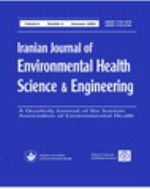
|
Iranian Journal of Environmental Health, Science and Engineering
Iranian Association of Environmental Health (IAEH)
ISSN: 1735-1979
Vol. 4, No. 2, 2007, pp. 133-138
|
 Bioline Code: se07020
Bioline Code: se07020
Full paper language: English
Document type: Research Article
Document available free of charge
|
|
|
Iranian Journal of Environmental Health, Science and Engineering, Vol. 4, No. 2, 2007, pp. 133-138
| en |
USEFUL FIELD OF VIEW AND RISK OF ACCIDENT IN SIMULATED CAR DRIVING
Allahyari, T.; Saraji, G. Nasl; Adl, J.; Hosseini, M.; Younesian, M. & Iravani, M.
Abstract
This study investigated the relationship between Useful Field of View and simulator-driving performance
measures. Ninety professional drivers, aged 22-65 years from several government organizations voluntarily
participated at this study. Useful Field of View was measured by a computerized task was developed at the
present study. The participants then performed a driving simulator task and experienced a scenario that
could lead to an accident. Reaction time and speed were measured and recorded by simulator and general
driving performance and collision events were recorded by examiner. The reduction of Useful Field of
View based on subject’s error score on Useful Field of View subtests between young and old group
statistically was analyzed. Correlation analyses used to examine the relationship among the Useful Field of
View as an independent variable and driving performance measures as a dependent variables. A univariate
logistic regression analysis was used to determine the extent to which reduction of Useful Field of View
predicts risk of accident in simulated car driving. There was a significant and negative correlation between
Useful Field of View and simulator performance, on the divided peripheral subtest (Correlation
Coefficient=-0.28). Student’s t-tests revealed significant differences in peripheral scores of Useful Field of
View subtests between accident involved and non-involved groups. The result of logistic regression
indicated that 40% reduction of Useful Field of View, regardless of age, increased risk of accident
involvement. Useful Field of View could be used to predict driving performance and risk of accident. The
obtained result can help to identify a high risk driver which is useful to licensing authorities.
Keywords
Useful Field of View, driving simulator, driving performance, BRT
|
| |
© Copyright 2007 - Tehran University of Medical Sciences Publications
Alternative site location: http://diglib.tums.ac.ir/pub/
|
|
